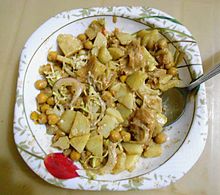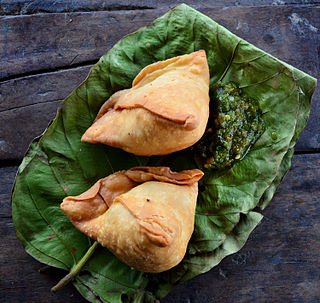
A samosa from the Persian word Sambosag (سنبوسگ) is a fried South Asian and West Asian snack. It is a pastry with a savory filling, mostly vegetables, spiced potatoes, onions, peas, also non-vegetarian meat, or fish. It is made into different shapes, including triangular, cone, or crescent, depending on the region. Samosas are often accompanied by chutney, and have origins in medieval times or earlier. Sweet versions are also made. Samosas are a popular entrée, appetizer, or snack in the cuisines of India, South Asia, West Asia, Central Asia, East Africa and their South Asian diasporas.

Panipuri is a deep-fried breaded hollow spherical shell, about 1 inch (25 mm) in diameter, filled with a combination of potato, onion and chickpea. It is a common street food in the Indian subcontinent. It is often spiced with tamarind chutney, chili powder, or chaat masala.

Chaat, or chāt is a family of savoury snacks that originated in India, typically served as an hors d'oeuvre or at roadside tracks from stalls or food carts across South Asia in India, Pakistan, Nepal and Bangladesh. With its origins in Uttar Pradesh, India, chaat has become immensely popular in the rest of South Asia.

Puri, also poori, is a type of deep-fried bread, made from unleavened whole-wheat flour, originated from the Indian subcontinent.
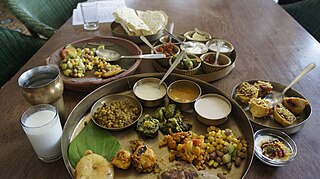
Gujarati cuisine is the cuisine of the Indian state of Gujarat. The typical Gujarati thali consists of rotli, dal or curry, rice, and shaak. The thali will also include preparations made from pulses or whole beans such as moong, black eyed beans etc., a snack item (farsaan) like dhokla, pathra, samosa, fafda, etc. and a sweet (mishthaan) like mohanthal, jalebi, sevaiya etc.

Papri chat or papri chaat is a popular traditional fast food and street food from the Indian subcontinent, in India, Bangladesh, Nepal and parts of Pakistan. Many various additional dishes throughout India are also referred to as papri chat. Some restaurants in the United States serve the traditional version of the dish.

Odia cuisine is the cuisine of the Indian state of Odisha. Compared to other regional Indian cuisines, Odia cuisine uses less oil and is less spicy, while nonetheless remaining flavourful. Rice is the staple food of this region. Mustard oil is used in some dishes as the cooking medium, but ghee is preferred in temples. Odia foods traditionally served either on brass, bronze metal plates, banana leaf or disposable plates made of sal leaves.
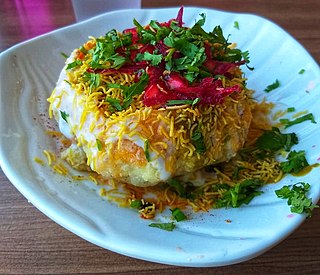
Kachori is a deep-fried, spicy, stuffed pastry originating from the Marwar region of Rajasthan, India. It is made of maida filled with a stuffing of baked mixture of moong dal or onions, besan, coriander, red chili powder, salt, and other Indian spices and deep-fried in vegetable oil until crispy golden brown. It is served hot with sweet and spicy tamarind chutney or occasionally with mint and green chilli chutney.
Bhojpuri cuisine is a style of food preparation common among the Bhojpuri people of Bihar, Jharkhand and eastern Uttar Pradesh in India, and also the Terai region of Nepal. Bhojpuri foods are mostly mild and tend to be less hot in terms of spices used. The cuisine consists of both vegetable and meat dishes.
Bihari cuisine is eaten mainly in the eastern Indian state of Bihar, as well as in the places where people originating from the state of Bihar have settled: Jharkhand, Eastern Uttar Pradesh, Bangladesh, Nepal, Mauritius, South Africa, Fiji, some cities of Pakistan, Guyana, Trinidad and Tobago, Suriname, Jamaica, and the Caribbean. Bihari cuisine includes Angika cuisine, Bhojpuri cuisine, Maithil cuisine and Magahi cuisine. Dal Puri
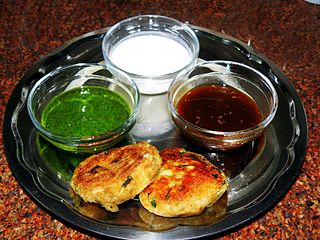
Aloo tikki, also known as aloo ki tikkia, aloo ki tikki or alu tikki, is a snack originating from the Indian subcontinent. In Indian, Pakistani, and Bangladeshi preparation, it is made of boiled potatoes, peas, and various curry spices. Aloo means potato in Hindi-Urdu, and tikki is a small cutlet or croquette. The dish is served hot along with a side of saunth, tamarind, and coriander-mint sauce, and sometimes dahi (yogurt) or chickpeas.
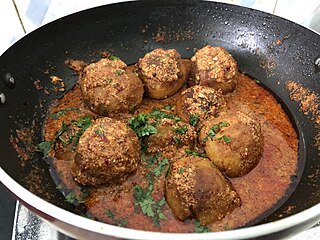
Dum aloo, aloor dum or aloo dum is a potato-based curry dish. The word dum translates to as steam-cooked or slow-cooked, while aloo means potato. It is a part of the traditional Kashmiri Pandit cuisine, from the Kashmir Valley, in the Indian state of Jammu and Kashmir. Dum aloo is cooked widely in India and Pakistan. There are also Banarasi and Bengali variations.
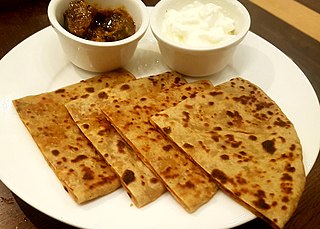
Aloo paratha is a paratha stuffed with potato filling native to the Indian subcontinent. It is traditionally eaten for breakfast.

Aloo gosht is a meat curry, and is a popular dish in North Indian, Pakistani, and Bangladeshi cuisine. It consists of potatoes (aloo) cooked with meat (gosht), usually lamb or mutton or beef, in a stew-like shorba gravy. It may be considered a curry, stew, or shorba depending on the way the dish is prepared, the types of spices used and what country or particular region it was made in. The dish can be served and eaten with plain rice or with bread such as roti, paratha or naan.

Vada, vadai, wada, bara, or bora is a category of savoury fried snacks native to India. Vadas can be described variously as fritters, cutlets, or dumplings. Vadas are sometimes stuffed with vegetables and traditionally served with chutneys and sambar.
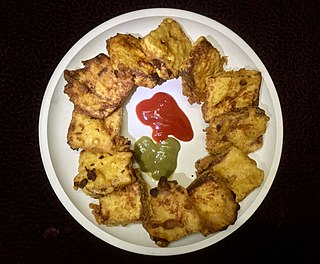
Bread pakora is an Indian fried snack. It is also known as bread bhaji. A common street food, it is made from bread slices, gram flour, and spices among other ingredients.

Dahi or curd, also mosaru, dahi, thayir and perugu, is a traditional yogurt or fermented milk product originating from and popular throughout the Indian subcontinent. It is usually prepared from cows' milk, and sometimes buffalo milk or goat milk. The word curd is used in Indian English to refer to homemade yogurt, while the term yogurt refers to the pasteurized commercial variety known as "heat-treated fermented milk".

Dahibara Aludum is a variant of Dahi vada and originated from Cuttack of the state Odisha. It is a type of chaat (snack) from Cuttack and is popular throughout India. The dish is prepared by soaking vadas in light dahi (yogurt) water which is tempered with mustard seeds and curry leaves. Then adding Aludum and Ghugni to it.
